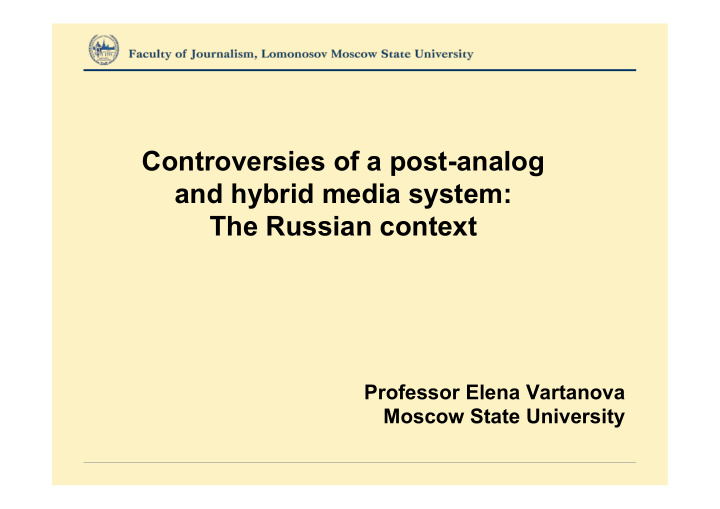



Controversies of a post-analog and hybrid media system: The Russian context Professor Elena Vartanova Moscow State University
Why BRICS Media Systems? • Effects of digitalization and convergence on BRICS media industries which are rooted in less developed industrial economies and different business and economic models of media enterprises compared to theoretically dominant Western ones, • Transition of traditional ‘media-state-politics’ relation paradigms under the influence of ‘democracy’ and ‘free market’ concepts, • Clashes of old and new regulatory paradigms into national media policy making process put into a broad context of modern geopolitics, • Nature of journalism, an interplay of national and global standards and ethics in construction of professional cultures and journalists’ professional identity.
Case of Russian Media System (1) • Conduct-structure-performance of media industry at large and corporate routines of media companies in particular, • A broader media regulation’s picture where external and internal influences are included in there complexity and numerous impacts of multiple drivers in policy-making, • Diverse audience demand for digital content for multiple platforms, • Journalism ethics/standards and cultural/creativity traditions in journalistic production.
Case of Russian Media System (2) • The rise of the digital media economy and the impact of (regional) state authorities on regional media business models, • The emergence of multiple streams in media policy characterized by uneven interests of old and new stakeholders, • The growing conflict of generational values based on complex number of socio-economic indicators of which politics is not the key one, thus reflecting new audience demand for content and clashes of professional journalistic standards.
Media Structures (1) • Understanding print media as a core normative value for older generation, • Widespread free on air television (20 national broadcast TV channels) as a backbone of national of media system which remain a major source of general news for mass audience, main advertising channel and still play a key role in making social unity as well as identity building, • Traditional attitudes to audience as ‘masses’.
Media Structures (2) • New struggle of free on air TV with paid TV channels (cable, satellite, OTT, etc.) which fragments major economic resources - both audience attention and advertising market, • Increasing access to and use of online and mobile media resulting in the rise of digital media culture as an indicator of digital life style and new forms of social inequalities (digital divide), • Substitution of old/traditional media by new media (social networks) in the daily routines of audiences with subsequent transformation of media nature. While old media have been characterized by one-directional distribution of professionally produced content in newsrooms to passive audiences, new media provide users with professionally (in newsrooms, but also in press- offices, corporate services and advertising agencies) and non-professionally (by bloggers, UGC) content. New media also provide multiplatform and multidimensional distribution and combine information supply with communication services which make media consumption process more sophisticated.
Media Economy • The first trend is shaped by fast changes in media consumption. About 50% of Russians in their 18-44 years old consume news online while only 30% of ‘45-64’ group follow the same pattern • The second trend is been determined by the shift from the advertising-driven business model, which now prevails in the scale of national media system, to the content sale-based model.
Basic scenarios of Russian media industry development (1)
Basic scenarios of Russian media industry development (2) • ‘Inertial’: it supposes continuation of existing practices of media consumption and retaining the advertising model as the key on in media business. • ‘Nonlinear television-based’: tt underlines an importance of the revenue growth from the content sales with the preservation of the old media consumption model based on watching the TV content. • ‘Revolutionary’: a mass refusal from the old media consumption practices and simultaneous rapid content sales growth is envisaged. • ‘Customization-oriented’: it might be described by implementing spread of a new media consumption model with retaining the advertise-driven model.
Media Policy • State-driven logic. The state is the most active actor in planning a shift to the digital in terms of media infrastructure. It is also the most powerful actor to make frameworks for the economic support to production of certain types of media content (for minorities or particular cultural products). • Industrial / market-driven logic . Major motivation is profit making one, and therefore policy making is realized through adoption of particular laws (Advertising law) and lobbying activity of employers associations. • Professional/ corporate logic. This is realized through self-regulatory mechanisms which are either weak and non-unifying (Code of Russian journalists) or protective from introduction of legal restrictions (Antiterrorism charter(s) as response to the introduction of censorship). • Civil society/ public logics. Cases are not numerous but mostly they are public/internet discussions about the media performance.
Conclusions • Contradictory features of ‘the old’ and ‘the new’, • Conflicts of digital and analogue approaches to media business and media policies, tensions between ‘digital natives’ and ‘digital migrants’ as drivers of content production and consumption • Essential regulative, economic and agenda-setting role of the Russian state in the media landscape though the Russian ‘state’ is no more a unified and even entity which makes state-media interrelations complex, multi-layer and imbalanced.
Recommend
More recommend